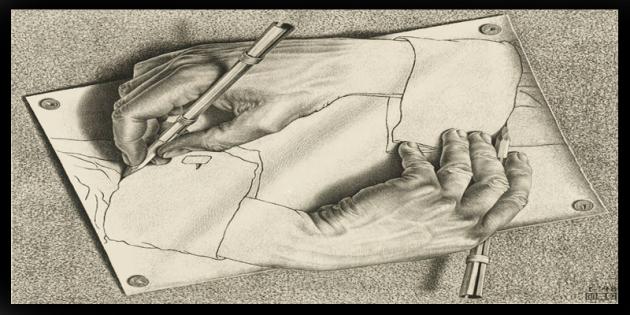We recently reported on the opening of ‘The Amazing World of M. C. Escher’ in Scotland and now here is some information on this must see exhibition, which is travelling to London, to be mounted at the Dulwich Picture Gallery (14 October 2015 – 17 January 2016) This will be the first major UK retrospective of original work by the great Dutch graphic artist Maurits Cornelis Escher (1898–1972) offering a rare opportunity to rediscover a giant of twentieth-century art and master of illusion and paradox.
Escher created some of the most popular images in modern art despite operating quietly at the fringes of the art world. His name instantly conjures up images of hands drawing hands, impossible staircases and distorted self-portraits in mirrored spheres. He succeeded in transforming his observations of reality into fascinating worlds, seducing and enchanting the viewer with drawings and lithographs that, over the years, have become part of our visual language – adorning teenagers’ bedrooms and appearing on famous LP covers. Often classed as a graphic illustrator this mesmerising exhibition of original drawings, iconic and lesser known prints, lithographs, woodcuts and archive material will highlight his supreme skill as a master draughtsman and unparalleled technical ability.
The exhibition comes to Dulwich following its run at the Scottish National Gallery of Modern Art. It will showcase over 100 works as well as previously unseen archive material from the collection of the Gemeentemuseum Den Haag, The Netherlands. Arranged chronologically, the show stretches across Escher’s whole career, tracing the periods that inspired his unique creativity.
Travel was hugely influential in the development of Escher’s work. He lived in Rome for ten years, taking annual trips through various parts of Italy where, inspired by the mountainous scenery and picturesque towns and buildings, he created irregular perspectives, impossible in natural form. In Still Life with Mirror (1934) for example, we see Escher using surreal illusion perhaps for the first time. When he moved to Switzerland in 1935 and then Belgium in 1938 he worked from images in his mind, rather than directly from observations. Escher focused on the concept of eternity in art – the subject of the well-known lithograph Drawing Hands (1948).
A shift in interest was also prompted when he re-visited the fourteenth-century palace of the Alhambra in Granada, Spain in 1936, where he became enraptured by the Moorish fortress’ tiled walls of tessellated mosaics. He coined the phrase ‘regular division of the plane’ describing his technique of tessellation which enabled him to express eternity and infinity in a single print.
This is no more evident than in the woodcut Metamorphosis II (1939-40). Nearly four metres in length, it has tessellations both simple and complex effortlessly merging into each other; from fish to birds; hives to bees; simple blocks to stretching panoramas which then morph into chess pieces. The technique is also adopted in the extraordinary lithograph Reptiles (1943), where creatures crawl, fully formed, from a flat, two-dimensional drawing. This play between the two dimensional and the three dimensional, between art and reality, and between the ‘real’, the reflected and the imaginary, would remain constants in Escher’s art.
Escher’s world is one of playful imagination and the unexpected, executed with mathematic precision to create impossible, timeless realities that would inspire amazement in the viewer. He often communicated with – and absorbed much from – academics, most notably the British-born mathematicians H.S.M. Coxeter (1907-2003) and Sir Roger Penrose (b. 1931). Both were quick to grasp the complexities and originality of Escher’s work; Penrose was hugely influential in the creation of two of Escher’s most celebrated works, Ascending and Descending (1960) and Waterfall (1961) where, in the latter, the mathematician’s “impossible triangle” was thrice-slotted into the picture to create a flowing yet physics-defying water structure.
Throughout the decades Escher’s work has become truly ubiquitous, pervading popular culture in a way few other artists have achieved. His images have appeared on album covers (Mott The Hoople), his concepts in films both classic (Labyrinth) and contemporary (Inception), and countless homages to the artist have surfaced on television (The Simpsons, Family Guy) and most recently in the gaming app Monument Valley. However, the artist was not always happy about his images being used. He famously turned down a plea from Mick Jagger to design a Rolling Stones album cover.
The exhibition has been organised by the Scottish National Gallery of Modern Art in Edinburgh. Patrick Elliott, the Gallery’s Senior Curator, said: “There are two qualities one needs to become a great artist: imagination and technique, and Escher had both in spades. There aren’t many artists whose work makes your jaw drop, but he’s one of them. The odd thing isn’t that we are showing Escher’s work, it’s that few people thought of showing him before”.
Ian A. C. Dejardin, Sackler Director of Dulwich Picture Gallery, said: “It is difficult to think of an artist with a broader appeal than M C Escher. His images are so magical, and so incredibly clever, that he creates impossible images that feel utterly real, like the very best fantasy writers. Enjoying these impossible realities, it’s easy to overlook the astonishing skill that has gone into the drawing. This exhibition is a revelation; the artist defies categorisation, but Escher is a worthy addition to Dulwich’s wonderful series of exhibitions devoted to graphic artists.”

